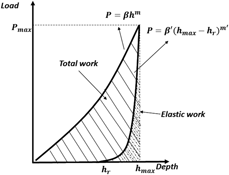Crossref Citations
This article has been cited by the following publications. This list is generated based on data provided by
Crossref.
Du, Liqun
Zhai, Ke
Wang, Shuxuan
Zhang, Xi
Cao, Qiang
Wen, Yikui
Zhao, Wenjun
and
Liu, Junshan
2020.
Evaluation of residual stress of metal micro structure electroformed with megasonic agitation.
Journal of Manufacturing Processes,
Vol. 59,
Issue. ,
p.
629.
Turla, Prashanth
Patel, Hinal
and
Pelegri, Assimina A.
2020.
On the transverse indentation moduli of high-performance KM2 single fibers using a curved area function.
Acta Mechanica,
Vol. 231,
Issue. 6,
p.
2113.
Zhang, Jianzhong
Tan, Tao
Duan, Chao
Li, Zhuoshu
Liu, Xianghe
Chai, Quan
Xiao, Gui
Tian, Ye
Zhang, Weibin
and
Xu, Yao
2022.
Measurement of Residual Stress Based on a Ring FBG Array.
IEEE Transactions on Instrumentation and Measurement,
Vol. 71,
Issue. ,
p.
1.
Peng, Bo
and
Ye, Duyi
2022.
Assessing the Residual Stresses in Dissimilar Welded Joint: Depth-Sensing Indentation Testing and Numerical Simulation.
Metals and Materials International,
Vol. 28,
Issue. 11,
p.
2798.
Mussatto, Andre
Groarke, Robert
Vijayaraghavan, Rajani K.
Hughes, Cian
Obeidi, Muhannad Ahmed
Doğu, Merve Nur
Yalçin, Mustafa Alp
McNally, Patrick J.
Delaure, Yan
and
Brabazon, Dermot
2022.
Assessing dependency of part properties on the printing location in laser-powder bed fusion metal additive manufacturing.
Materials Today Communications,
Vol. 30,
Issue. ,
p.
103209.
Yan, Zan
2022.
Controllable Synthesis and Mechanical Properties of Nano Titania-Based Functional Materials.
Russian Journal of General Chemistry,
Vol. 92,
Issue. 8,
p.
1528.
Patel, Hinal R.
Flood, Shannon H.
Raju, Hermise
Tenorio, Max C.
and
Pelegri, Assimina A.
2022.
Nanoindentation of freestanding single Kevlar® fibers with an adjusted indentation area function.
Journal of Materials Research and Technology,
Vol. 19,
Issue. ,
p.
1472.
Liu, Ming
Zheng, Qiang
Wang, Xin
and
Xu, Chunling
2022.
Characterization of distribution of residual stress in shot-peened layer of nickel-based single crystal superalloy DD6 by nanoindentation technique.
Mechanics of Materials,
Vol. 164,
Issue. ,
p.
104143.
Cao, Taifeng
Su, Peng
Xu, Zhiheng
Feng, Zeqiang
Wang, Shaohua
and
Qiao, Junwei
2023.
Evaluation of residual stress in lead frame copper strips by nanoindentation.
Journal of Materials Science,
Vol. 58,
Issue. 13,
p.
5884.
Liu, Ming
Zheng, Qiang
Wang, Xin
and
Xu, Chunling
2023.
Characterization of Distribution of Microstructure and Micro-mechanical Properties of Nickel-Based Single Crystal Superalloy Within the Shot-Peened Layer.
Metals and Materials International,
Vol. 29,
Issue. 8,
p.
2257.
Duan, Chao
Tan, Tao
Tian, Ye
Chai, Quan
Zhang, Jianzhong
Yang, Minghong
Fan, Xinyu
Zhang, Jianzhong
and
Kim, Chang-Seok
2023.
Residual stress measurement of non-uniform materials based on distributed optical fiber ring array.
p.
18.
Gao, Feinong
Xie, Lijing
Peng, Mingjian
Sun, Ting
Li, Xingyu
Pang, Siqin
and
Wang, Xibin
2024.
Micro-mechanical properties characterization of shot peening strengthened layer with nanoindentation.
Mechanics of Materials,
Vol. 197,
Issue. ,
p.
105072.
Lucio-Rosales, Daniela
Torres-Torres, David
and
Garcia-Garcia, Alejandra
2025.
A focused study of the out-plane mechanical properties and the spiral growth of MoS2 structures.
Surface and Coatings Technology,
Vol. 504,
Issue. ,
p.
132034.



